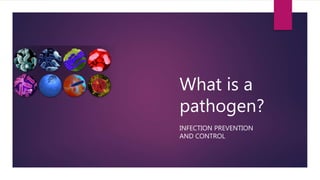
Pathogens
- 1. What is a pathogen? INFECTION PREVENTION AND CONTROL
- 2. What is a pathogen? A pathogen is a bacterium, virus, or other microorganism that can cause disease. In biology, a pathogen, in the oldest and broadest sense, is anything that can produce disease. A pathogen may also be referred to as an infectious agent, or simply a germ. The term pathogen came into use in the 1880s. A variety of microorganisms can cause disease. Pathogenic organisms are of five main types: viruses, bacteria, fungi, protozoa, and worms.
- 3. Virus DNA Virus Uses DNA as its genetic material. Replicates using DNA-dependent DNA- polymerase. Hepatitis B Virus (some classifications) Chickenpox virus (varicella) Human papilloma virus Herpes virus RNA Virus Uses RNA as its genetic material. Sometimes called riboviruses Ebola, SARS, common cold, West Nile, rabies, influenza, polio Subset uses DNA Intermediates for replication, called retroviruses HIV-1 HIV-2 Human Immunodeficiency Virus (green) Coming from host lymphocyte.
- 4. Bacteria Bacterial Type: Cocci Gram Positive Neisseria Neisseria gonorrhonae Gonorrhea (sexually transmitted) Neisseria meningitides Many bacterial meningitis cases Bacterial Type: Cocci Gram Negative Staphylococci Staphylococcus aureus Streptococci Streptococcus pyrogens Strep throat Scarlet fever Cocci Spherical in chains
- 5. Bacteria Bacterial Type: Bacillus Gram Positive Bacillus anthracis Anthrax Listeria monocytogenes Listeriosis (often meningitis, encephalitis) Bacterial Type: Bacillus Gram Negative Salmonella species Salmonella gastritis Vibrio species Vibrio cholerae Cholera Legionella species Legionnaires disease Bacillus bacteria (rod shaped)
- 6. Bacteria • Anaerobic Bacteria • Does not grow or survive in the presence of oxygen. • Grows in oxygen poor or oxygen free environment. • Clostridium botulinum • Botulism • Clostridium tetani • Tetanus • Clostridium perfringens • Gas gangrene Patient with gas gangrene of upper left leg prior to amputation. Source: https://upload.wikimedia.org/wikipedia/commons/8/81/Gas_gangrene.jpg
- 7. Bacteria • Spirochete Bacteria • Characteristic spiral shape of bacteria. • Varied subspecies, may are pathogens. • Treponema pallidum • Syphilis • Borrelia burgdorferi • Lyme disease • Leptospira interrogans • Leptospirosis Treponema pallidum - note spiral shape of bacteria
- 8. Bacteria • Mycobacterium • “myco” is the Greek prefix meaning fungus. This reflects the way that the bacteria grow in culture, resembling fungus. • Mycobacterium tuberculosis • Tuberculosis • Mycobacterium leprae • Hanson’s disease (leprosy) • Mycobacterium ulcerans • Buruli ulcers Micrograph of Mycobacterium tuberculosis
- 9. Bacteria • Rickettsia • Gram negative, non-spore forming, usually cocci shaped obligate intracellular parasitic bacteria. • Rickettsia rickettsii • Rocky Mountain spotted fever • Rickettsia typhi • Murine typhus • Rickettsia prowazekii • Epidemic typhus Micrograph of Rickettsia ricketsii living inside cells of a tick. NOTE: Rickettsia IS NOT associated with the disease “Rickets”.
- 10. Bacteria • Chlamydia • Gram negative, obligate intracellular parasitic bacteria, smaller than many virus. • Chlamydia trachomatis • STD chlamydia, trachoma (blindness) • Chlamydophilia pneumoniae • Form of pneumonia • Chlamydophilia psattici • psittacosis (parrot fever) Micrograph of Chlamydia trachomatis.
- 11. Bacteria • Mycoplasmas • Smallest bacteria yet identified. Often antibiotic resistant due to lack of a cellular wall. • Mycoplasma pneumoniae • Atypical pneumonia • Mycoplasma genitalium • Pelvic inflammatory disease • Mycoplasma incognitus • suspected in chronic fatigue syndrome and rheumatoid arthritis Micrograph of Micoplasma haemofelis (Feline Infectious Anemia).
- 12. Fungi • Primarily yeasts and molds. • Family includes mushrooms. All species have chitin in their cell walls making them resistant to toxins and antibiotics. • Candida albicans • Candidias • Thrush if oral • Yeast infection if vaginal • Cryptococcus neoformans • Fungal meningitis and encephalitis • Histoplasma capsulatum • Histoplasmosis (pneumonia from bird droppings) Candidias (oral thrush) on the tongue of a young woman.
- 13. Protozoa • Single celled, animal like, microorganisms. • May be predatory, free-living or parasitic. • Entamoeba histolytica • Amoebiasis (amoebic dysentery) • Toxoplasma gondii • Toxoplasmosis (usually from exposure to cat feces). • If infected during pregnancy causes Congenital Toxoplasmosis in fetus. • Cryptosporidium • Cryptosporidiosis (protozoan parasitic bowel disease) Entamoeba histolytica with ingested human red blood cells (dark circles).
- 14. Worms • Parasitic worms entering the body by ingestion or skin penetration. • Cestodes (multiple species) • Tape worms (pork, beef or other source) • Trematodes (flukes, multiple species) • Liver infection (snail liver) and swimmer’s itch (skin infection) • Nematodes (round worms, multiple species) • Primarily intestinal or intestinal at some phase in life cycle. Hook worms attached to intestinal mucosa.
- 15. Summary A pathogen is an organism that causes disease by infection of a human host. Compare to a symbiotic microorganism that benefits the human host by living in or on them and benefiting their physiology (symbiotic coliform bacteria in the intestinal tract or the flora of the skin). The major types of pathogens are: Virus Bacteria Fungi Protozoa Worms
